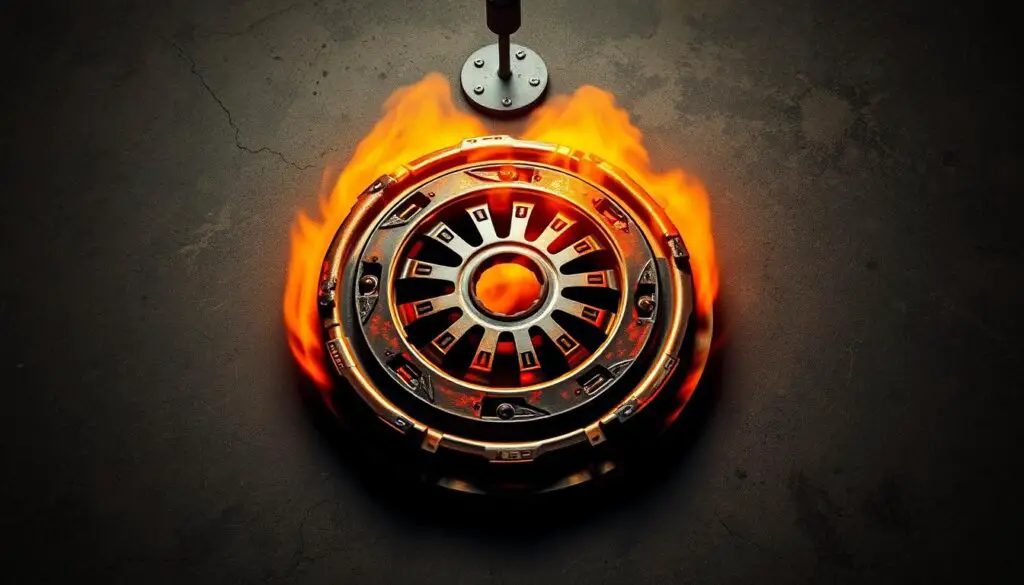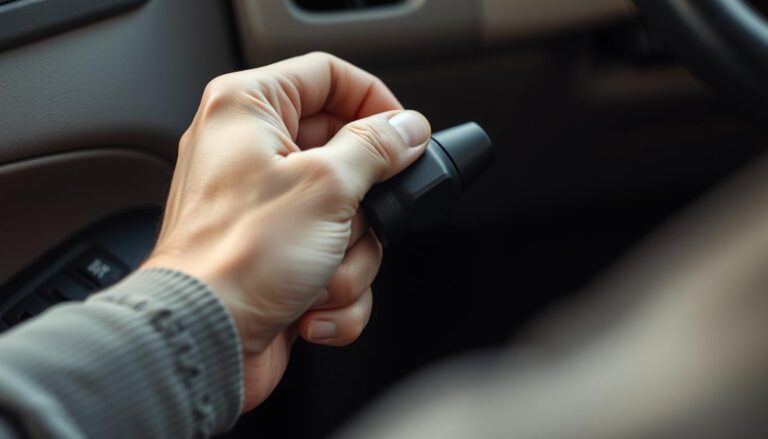Mastering clutch care is essential for drivers who want to avoid costly repairs down the line. A well-maintained clutch not only ensures the longevity of your vehicle’s transmission system but also enhances your overall driving experience.
For drivers with manual transmission vehicles, proper clutch maintenance is crucial. By adopting proper driving techniques and understanding the mechanics of your vehicle’s clutch, you can significantly reduce the risk of premature wear and tear.
Key Takeaways
- Proper clutch care can help avoid costly repairs.
- A well-maintained clutch enhances the overall driving experience.
- Manual transmission vehicles require special clutch maintenance.
- Adopting proper driving techniques can reduce clutch wear.
- Understanding clutch mechanics is crucial for longevity.
Understanding Your Vehicle’s Clutch System
Understanding the intricacies of your vehicle’s clutch system is essential for any driver looking to master clutch care. The clutch system is a complex assembly that plays a critical role in the operation of manual transmission vehicles.

The Anatomy of a Clutch: Pressure Plate, Disc, and Flywheel
The clutch system consists of several key components: the pressure plate, clutch disc, and flywheel. The pressure plate applies pressure to the clutch disc, which is situated between the pressure plate and the flywheel. The flywheel, attached to the engine’s crankshaft, provides a friction surface for the clutch disc.
When the clutch pedal is pressed, it disengages the clutch disc from the flywheel, allowing the driver to shift gears. The smooth operation of these components is crucial for efficient power transfer and to prevent premature wear.
How the Clutch Transfers Power in Manual Transmissions
In manual transmissions, the clutch system facilitates the transfer of power from the engine to the gearbox. When the clutch pedal is released, the clutch disc engages with the flywheel, transferring engine power to the transmission. This process enables the vehicle to move forward or backward, depending on the gear selected.
For more insights on how manual transmissions work and their interaction with the clutch system, you can visit this resource for additional information.
Different Types of Clutch Systems in Modern Vehicles
Modern vehicles employ various types of clutch systems, including:
- Mechanical Clutches: Operated by a cable or linkage, these clutches are directly connected to the clutch pedal.
- Hydraulic Clutches: These use hydraulic fluid to actuate the clutch, providing a smoother pedal feel.
- Cable-Actuated Clutches: Using a cable to connect the clutch pedal to the clutch mechanism, these are simpler but can be more prone to wear.
Each type of clutch system has its unique characteristics and maintenance requirements. Understanding these differences is key to proper clutch care and maintenance.
How Do You Burn a Clutch: Understanding the Causes and Prevention
Understanding how to properly use and maintain your vehicle’s clutch system is crucial to avoiding costly repairs. The clutch is a vital component of manual transmissions, and its misuse can lead to premature wear and potentially catastrophic failure.

Riding the Clutch: The Number One Cause of Premature Wear
Riding the clutch is a habit that can significantly reduce the lifespan of your clutch. It involves partially pressing the clutch pedal, causing excessive friction and heat buildup. This can lead to clutch burnout, a condition where the clutch fails to engage or disengage properly.
To avoid this, drivers should practice smooth acceleration and gentle clutch engagement. When stopping, it’s advisable to shift into neutral and release the clutch to prevent unnecessary wear.
Improper Shifting Techniques That Damage Your Clutch
Improper shifting techniques can also damage your clutch. Forcing gears or shifting too slowly can cause the clutch to wear down faster. It’s essential to shift gears smoothly and quickly, using the correct gear for the speed you’re traveling.
- Use the correct gear for your speed
- Shift gears smoothly and quickly
- Avoid forcing gears
Overloading Your Vehicle and Its Impact on Clutch Life
Overloading your vehicle puts additional strain on the clutch, leading to increased wear and tear. It’s crucial to be mindful of your vehicle’s load capacity and avoid overloading it with heavy cargo or towing large trailers.
By being aware of your vehicle’s limitations, you can help extend the life of your clutch and prevent premature failure.
Preventive Measures to Avoid Clutch Burnout
To prevent clutch burnout, it’s essential to adopt proper driving techniques and maintain your vehicle’s clutch system regularly. This includes checking for signs of wear, ensuring proper clutch adjustment, and addressing any issues promptly.
- Practice smooth acceleration and gentle clutch engagement
- Regularly inspect your clutch system for signs of wear
- Avoid overloading your vehicle
Recognizing the Warning Signs of Clutch Damage
Understanding the warning signs of a failing clutch is crucial for maintaining your vehicle’s performance and avoiding expensive fixes. A clutch system is complex, and its failure can lead to significant inconvenience and repair costs. Being aware of the symptoms that indicate potential clutch damage can help you take proactive measures.
Grinding, Squealing, and Other Auditory Warning Signs
One of the first indicators of clutch damage is unusual noises. Grinding or squealing sounds when you press the clutch pedal can signal wear or misalignment. These noises occur because the clutch components are not engaging or disengaging smoothly. If you notice such sounds, it’s essential to investigate further.
Other auditory signs include rattling or chirping noises, which can indicate a problem with the clutch release bearing or other components. Ignoring these sounds can lead to more severe damage over time.
Changes in Pedal Feel: Sponginess, Stiffness, and Vibration
A change in the feel of the clutch pedal is another warning sign. A spongy or soft clutch pedal might indicate air in the hydraulic system or worn-out clutch components. Conversely, a stiff clutch pedal could suggest a problem with the clutch cable or hydraulic system. Additionally, vibrations when engaging the clutch can signal a worn-out or misaligned clutch.
Performance Issues: Slipping, Difficulty Shifting, and Power Loss
Performance issues are also critical indicators of clutch damage. A slipping clutch can cause your engine to rev without a corresponding increase in speed, indicating that the clutch is not transferring power effectively. Difficulty shifting gears can be another symptom, often accompanied by a grinding or resistance when attempting to shift. Furthermore, a noticeable loss of power when accelerating can be a sign that the clutch is failing to engage properly.
| Warning Sign | Description | Possible Cause |
|---|---|---|
| Grinding/Squealing Noises | Noises when pressing the clutch pedal | Wear or misalignment of clutch components |
| Spongy/Stiff Clutch Pedal | Change in clutch pedal feel | Air in hydraulic system or worn-out components |
| Slipping Clutch | Engine revs without increasing speed | Clutch not transferring power effectively |
When to Seek Professional Diagnosis
If you notice any of these warning signs, it’s advisable to seek a professional diagnosis. A mechanic can assess the condition of your clutch and recommend necessary repairs. Early intervention can prevent further damage and save you money in the long run.
Mastering Proper Clutch Technique and Maintenance
To keep your manual transmission running smoothly, it’s vital to master proper clutch technique and maintenance. This not only enhances your driving experience but also plays a significant role in prolonging the life of your clutch system.
Smooth Engagement and Gear Shifting
The art of smooth engagement and gear shifting is fundamental to reducing wear on your clutch. It involves coordinating the clutch pedal with the accelerator to ensure a seamless transition between gears. Proper technique helps in minimizing the strain on the clutch, thereby extending its lifespan.
When shifting gears, it’s essential to pause briefly in neutral before moving into the next gear. This pause, known as “gearing through neutral,” helps reduce the stress on the clutch and transmission.
Hill Start Strategies
Starting on a hill can be challenging, but employing the right strategies can protect your clutch from excessive strain. One effective method is to use the handbrake when starting on an incline. By doing so, you can prevent the vehicle from rolling backward while allowing you to smoothly engage the clutch.
Another technique is to gradually release the clutch while simultaneously giving the vehicle some throttle. This balanced approach helps in smoothly starting on a hill without putting undue stress on the clutch.
Traffic Management
Managing your speed and avoiding frequent stop-and-go driving in heavy traffic can significantly help extend the life of your clutch. Anticipating traffic flow and maintaining a safe distance from the vehicle ahead can reduce the need for abrupt stops and starts, which are detrimental to the clutch.
Recommended Maintenance Schedule
Regular maintenance is crucial for the longevity of your clutch system. It’s recommended to check the clutch fluid level regularly and inspect the clutch components for signs of wear. A routine maintenance schedule can help identify potential issues before they become serious problems.
| Maintenance Task | Frequency | Importance Level |
|---|---|---|
| Check Clutch Fluid Level | Every 3,000 miles | High |
| Inspect Clutch Components | Every 10,000 miles | High |
| Replace Clutch Fluid | Every 30,000 miles | Medium |
Conclusion: Extending Your Clutch’s Lifespan and Saving Money
Extending the lifespan of your clutch and saving money on repairs requires a combination of proper driving techniques and regular clutch maintenance. By adopting the strategies outlined in this article, you can significantly reduce the risk of premature clutch wear and associated repair costs.
Mastering clutch care is not just about saving money; it’s also about ensuring your vehicle runs smoothly and efficiently. A well-maintained clutch provides a better driving experience and peace of mind on the road. By understanding your vehicle’s clutch system and recognizing the warning signs of clutch damage, you can take proactive steps to maintain your clutch and extend its lifespan.
Regular clutch maintenance, including inspections and adjustments, can help identify potential issues before they become major problems, resulting in cost savings. By incorporating these practices into your vehicle care routine, you can enjoy a longer clutch lifespan and reduced repair costs over time.
FAQ
What are the most common causes of clutch burnout?
The most common causes of clutch burnout include riding the clutch, improper shifting techniques, and overloading the vehicle. These habits can cause excessive friction and heat buildup, leading to premature wear and tear on the clutch system.
How can I prevent clutch burnout?
To prevent clutch burnout, adopt proper driving techniques such as smooth acceleration and gentle clutch engagement. Be mindful of your vehicle’s load capacity, and avoid riding the clutch or shifting gears abruptly. Regular maintenance checks can also help identify potential issues before they become major problems.
What are the warning signs of clutch damage?
Warning signs of clutch damage include unusual noises such as grinding or squealing, changes in pedal feel like sponginess or stiffness, and performance issues including slipping, difficulty shifting gears, and power loss. If you notice any of these signs, it’s advisable to seek a professional diagnosis to identify the root cause and undertake the necessary repairs.
How can I master proper clutch technique?
Mastering proper clutch technique involves developing skills such as smooth engagement and gear shifting. When driving in hilly terrain, employ the right hill start strategies to prevent excessive strain on the clutch. In heavy traffic, manage your speed and avoid frequent stop-and-go driving to extend the life of your clutch.
What is the recommended maintenance schedule for clutch systems?
The recommended maintenance schedule for clutch systems includes regular checks of the clutch fluid level and inspections of the clutch components for wear. By following a recommended maintenance schedule, you can identify and address potential issues before they become serious problems, ensuring your vehicle remains in good working condition.
How can I extend the lifespan of my clutch?
To extend the lifespan of your clutch, combine proper driving techniques with regular maintenance. Understand your vehicle’s clutch system, adopt smooth driving habits, and address any issues promptly to prevent premature wear and tear. By doing so, you can enjoy a better driving experience, reduce repair costs, and ensure your vehicle runs smoothly and efficiently.


